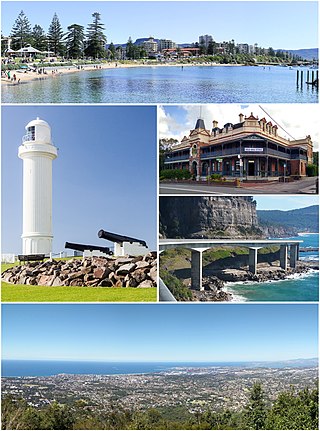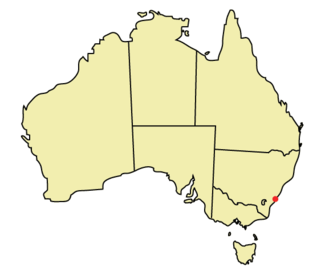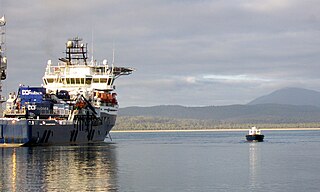
Wollongong, colloquially referred to as The Gong, is a city located in the Illawarra region of New South Wales, Australia. The name is believed to originate from the Dharawal language, meaning either 'five islands/clouds', 'ground near water' or 'sound of the sea'. Wollongong lies on the narrow coastal strip between the Illawarra Escarpment and the Pacific Ocean, 85 kilometres south of central Sydney. Wollongong had an estimated urban population of 302,739 at June 2018, making it the third-largest city in New South Wales after Sydney and Newcastle and the tenth-largest city in Australia by population. The city's current Lord Mayor is Gordon Bradbery AM who was elected in 2021.

Port Kembla is a suburb of Wollongong 10 km south of the CBD and part of the Illawarra region of New South Wales. The suburb comprises a seaport, industrial complex, a small harbour foreshore nature reserve, and a small commercial sector. It is situated on the tip of Red Point: its first European sighting was by Captain James Cook in 1770. The name "Kembla" is an Aboriginal word meaning "plenty [of] wild fowl".

Mount Keira is a suburb and mountain in the Illawarra region of New South Wales, Australia.

North Wollongong railway station is located on the South Coast railway line in New South Wales, Australia. It serves the Northern Wollongong suburb of North Wollongong, opening on 19 July 1915. It is the primary station for the University of Wollongong.

Port Kembla railway station is a single-platform intercity train terminal located in Port Kembla, Australia, on the South Coast railway line's Port Kembla branch. The station serves NSW TrainLink trains traveling north to Wollongong and Sydney. The station also serves as a stabling location for South Coast line trains.

Coalcliff is a town on the coast of New South Wales, Australia, between Sydney and Wollongong.

Clifton is a village on the coast of New South Wales, Australia, between Sydney and Wollongong. Along with nearby Coalcliff, the village began life as a coal-mining centre. It is situated on a narrow area between the sea and the Illawarra escarpment. The electrified South Coast railway line passes through, but the station at Clifton was closed in 1915. It reopened on 1934-07-04 and closed for the last time on 1983-11-27, at the time of double tracking and electrification.

Austinmer is a northern village of Wollongong on the south coast of New South Wales, Australia. It sits in the northern Illawarra region, south of Stanwell Park and immediately north of Thirroul.

Bellambi is a suburb of Wollongong in the Illawarra region of New South Wales, Australia. It has a railway station on the NSW TrainLink South Coast Line.

Wollongong Breakwater Lighthouse, also known as Wollongong Harbour Lighthouse, is a historic lighthouse situated on the southern breakwater of the heritage-listed Wollongong Harbour, in Wollongong, New South Wales in Australia. Wollongong is the only place in the east of Australia to have two lighthouses located in close proximity of each other, the other being Wollongong Head Lighthouse. While no longer used, the lighthouse was restored in 2002 as operational and is listed an official local heritage building.

The city of Wollongong has a distinct geography. It lies on a narrow coastal plain flanked by the Pacific Ocean to the east and a steep sandstone precipice known as the Illawarra Escarpment to the west, most notably Mount Keira, joined to the escarpment by a high saddle.

The Port of Eden is a small seaport situated in Twofold Bay, adjacent to the town of Eden, located in the South Coast region of New South Wales, Australia.

Bulli Jetty at Sandon Point, was first built in 1863 and was abandoned in 1943. During that time it was used by the Bulli Coal Company in the transportation of coal from the Bulli mine to the ships for export to other destinations.
The Dalfram dispute of 1938 was a political industrial dispute at Port Kembla, New South Wales, protesting the export of pig iron from Australia to Japan during the Second Sino-Japanese War. It became famous for providing the nickname of Pig Iron Bob to Attorney General Robert Menzies, later to serve as Prime Minister.
The coastal coal-carrying trade of New South Wales involved the shipping of coal—mainly for local consumption but also for export or coal bunkering—by sea to Sydney from the northern and southern coal fields of New South Wales. It took place in the 19th and 20th centuries. It should not be confused with the export coal trade, which still exists today. There was also an interstate trade, carrying coal and coke to other Australian states that did not have local sources of black coal.

Sixty-miler (60-miler) is the colloquial name for the ships that were used in the coastal coal trade of New South Wales, Australia. The sixty-milers delivered coal to Sydney from ports and ocean jetties to the north and south of Sydney. The name refers to the approximate distance by sea—actually 64 nautical miles—from the Hunter River mouth at Nobbys to the North Head of Sydney Harbour.

Wollongong Harbour Precinct is a heritage-listed shipping harbour at Cliff Road and Endeavour Drive, in Wollongong, New South Wales, Australia. It was built in 1837. The historic precinct includes Belmore Basin, Government Dam, Government Basin, Stockade Point, Flagstaff Hill, Signal Hill, Brighton Beach, Boat Harbour and Fortress Hill. It was added to the New South Wales State Heritage Register on 5 May 2010.

Edward Charles Roach (1909–1997), was an Australian trade unionist, long-time leader of the Waterside Workers' Federation (WWF) and prominent member of the Communist Party of Australia. He was a key organiser of the 1938 Dalfram dispute, when dock workers, concerned with the occupation of China, refused to load ships destined for Japan with Australian pig-iron, a raw material for munitions. He was twice imprisoned for his industrial activity. As a leader in the WWF during the introduction of containerisation, he was responsible for winning significant improvements in working conditions for those in the Australian stevedoring industry.

The Stone Fleet was the colloquial name for the small coastal ships that carried crushed-stone construction aggregate to Sydney from the Illawarra ports of Kiama and Shellharbour and the nearby ocean jetties at Bombo and Bass Point.

Charles Henry Hoskins (1851-1926) was an Australian industrialist, who was significant in the development of the iron and steel industry in Australia.
























